But the scope of the outbreak among cattle remains uncertain, and little human testing has been done.
Additional testing of retail dairy products from across the country has turned up no signs of live bird flu virus, strengthening the consensus that pasteurization is protecting consumers from the threat, federal health and agriculture officials said at a news briefing on Wednesday.
But the scope of the bird flu outbreak in cattle remains unclear, as dairy herds are not routinely tested for the infection, scientists and other experts have noted.
Just one human infection, which was mild, has been reported, in a dairy worker in Texas who had direct contact with sick cows. But scientists fear there may be many more undetected infections, particularly among farm workers.
Barely two dozen people have been tested for bird flu, federal officials said at the briefing. There have been no unusual increases in flu cases around the country, even in areas with infected cows, they added.
But Dr. Keith Poulsen, director of the Wisconsin Veterinary Diagnostic Laboratory, said that farms are not required to test employees, many of whom are migrant workers who are reluctant to work with state health officials.
“How much are we ignoring because of anxiety and fear of what happens if you don’t get an answer that you like?” Dr. Poulsen said.
Until last week, potentially tainted dairy products had seemed to be the most immediate threat to the public. Federal regulators last week announced early test results of around 95 retail milk samples: Roughly one in five was found to contain genetic fragments of the virus, a fact that health officials said did not present a threat to consumers.
More advanced testing later in the week turned up no live virus in the samples, a relief to federal regulators.
On Wednesday, Dr. Donald A. Prater, the acting director of the Center for Food Safety and Applied Nutrition at the Food and Drug Administration, said federal scientists had examined an additional 201 commercial dairy samples, including milk, cottage cheese and sour cream.
So far the scientists have not found evidence of potentially infectious virus. “Findings from the U.S. government partners, as well as academic researchers, do not change our assessment of the safety of the milk,” Dr. Prater said.
Dr. Prater said that the F.D.A. still strongly advised against consuming raw, unpasteurized dairy products. Federal scientists are still reviewing data on whether the virus in raw milk could be infectious, he added.
As of Wednesday, the outbreak had spread to 36 herds in nine states, according to the Department of Agriculture. Scientists have criticized the Biden administration for not conducting more testing of animals in order to determine the scope of the outbreak.
Some dairy farms have been difficult to gain access to, and owners are at times reluctant to grant government workers entry to production facilities, federal officials have said.
“There’s a lot of farms out there that are not reporting,” Dr. Poulsen, the Wisconsin expert, said. “They’re not reporting because they’re really afraid of what would happen if they’re not negative.”
The Department of Agriculture has ruled that lactating cows must test negative for influenza A viruses, a class that includes bird flu, before they are transported across state lines. The rule also requires owners of herds with positive tests to provide data on the whereabouts of cattle to help investigators trace the disease.
But further guidance released last week revealed that farmers need to test only 30 cows in a group, potentially allowing infected cows in larger herds to move between states undetected.
Dr. Rosemary Sifford, a senior U.S.D.A. official, defended the scope of the order, saying that 30 cows were a “statistically significant number to be able to determine the status of the lot.” The department now requires laboratories and state veterinarians to report any positive tests from cattle to the agency.
The U.S.D.A. also has turned its attention to meat. Colombia last week become the first country to ban beef and beef products from certain U.S. states because of the bird flu outbreak.
Dr. José Emilio Esteban, a senior food safety official at the U.S.D.A., said at the briefing that beef was safe to eat, but that the agency was conducting three studies to “enhance our scientific knowledge to make sure we have additional data points.”
The department is testing ground beef from grocery stores, as well as the remnants of slaughtered animals, in states known to have infected dairy cattle, Dr. Esteban said. The agency is also examining the effectiveness of cooking at killing the virus by heating beef patties to three different temperatures.
Officials are also considering possible ways to compensate dairy farmers for “their cooperation and taking up of additional biosecurity practices,” Dr. Sifford said.
Underlying much of the concern about the cattle outbreak is a fear among scientists that the bird flu virus is adapting to mammals. Dr. Sifford said at the briefing that federal scientists had not detected any changes in the virus that would allow it to spread more easily between humans.
Dr. Demetre Daskalakis, a senior official at the Centers for Disease Control and Prevention, conceded that only around 25 people had been tested for infection, about the same number reported last week.
More than 100 people are being monitored for symptoms. Dr. Daskalakis said that the numbers of people who were being tested and monitored were “dynamic,” in part because the monitoring period for people goes away as infected herds recover.
Emily Anthes contributed reporting.
